Southeastern Insights
February 2015
Southeastern Insights provides a broad summary of economic intelligence gathered through our network of business contacts and other sources throughout the Southeast during the latest Federal Open Market Committee (FOMC) cycle. This report covers the period from December 18, 2014, to January 28, 2015.
General business conditions
Our contacts' and directors' input during this FOMC cycle continued to be positive, although not quite as optimistic as in December. We heard upbeat stories about tourism, nonresidential and multifamily construction, transportation, and commercial real estate. However, there were mixed reports about holiday sales meeting expectations, uncertainty over the ramifications of rapidly falling energy prices, and concerns over a worsening global outlook. Regarding falling energy prices, it seemed to be good news for some companies and not so good news for others.
Reports from retail contacts were generally positive but not overwhelmingly so. Lower gas prices provided consumers an opportunity to increase their discretionary spending, but a frequent comment from retailers was that their year-over-year sales increases were not as large as expected. And while the rising value of the dollar was seen as a positive for those who buy imported goods, particularly high-end items, there were also reports from some firms that they were contemplating moving to offshore suppliers to make use of the dollar's strength or using the dollar's strength as a negotiating strategy with their domestic suppliers.
Tourism continued to be a bright spot for the District with increasing evidence that the decline in fuel prices was having a positive effect on "drive-to" destinations. Contacts indicated that any pullback on tourism spending resulting from the strength of the dollar had not yet materialized. Another sector that was doing well was transportation, as reports of increasing cargo volumes that were well above expectations were thought to be from real, organic growth, not a result of pent-up demand, which is unlike what's been reported in the past.
Real estate activity was still mixed. Single-family construction softened (see chart 1) while multifamily was doing very well. Office and industrial space was improving with construction activity being characterized as robust in some Southeast metro areas (see chart 2).
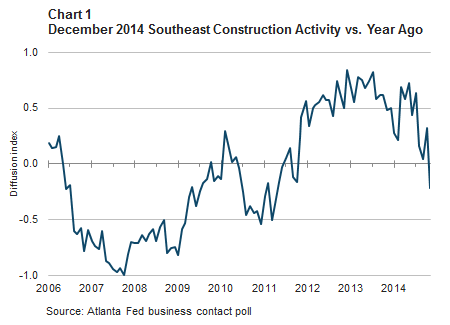
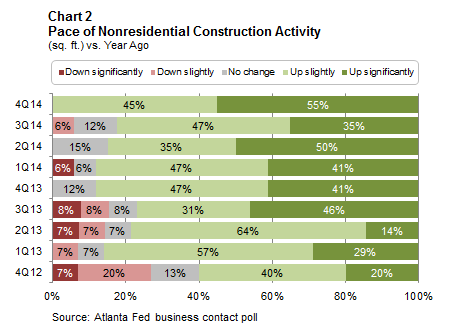
On the manufacturing front, regional manufacturing fell in December for the first time in 2014 after expanding the previous 11 consecutive months, according to Kennesaw State University's Southeast Purchasing Managers Index (PMI). The PMI fell below the 50-point threshold in December (see chart 3), signifying a contraction in activity for the sector.
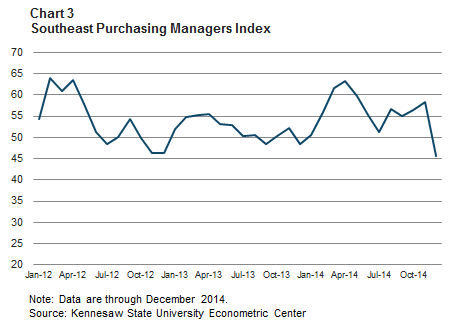
Employment
On balance, contacts reported that they continue to hire. In fact, data from the U.S. Bureau of Labor Statistics revealed that the District added 47,400 jobs on net in December and the unemployment rate declined from 6.4 to 6.2 percent (see charts 4 and 5).
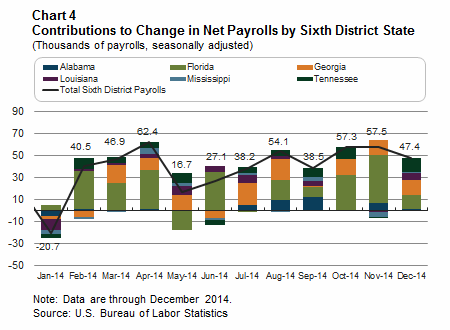
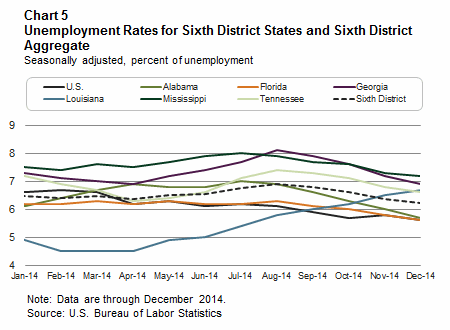
Job gains were fairly widespread across sectors, and the largest net gain occurred in education and health services (+10,600), the majority of which was in health services (+8,300). Other sectors in the District that saw big payroll increases were professional and business services (+9,800); trade, transportation, and utilities (+8,000); and leisure and hospitality (+6,700), where the majority of jobs were in accommodations and food services (+5,200).
We continued to hear reports about increased difficulties in recruiting. Something new we heard was that technology investments are being made to address the problem of not being able to find enough employees with the necessary job skills. In the past, spending on technology had often been undertaken to substitute technology for labor in order to reduce costs.
Input costs, wages, and prices
Input cost pressures continued to be a nonissue for most firms and overwhelmingly, the decline in fuel prices was seen as an opportunity to improve margins rather than lower prices. While contacts did not report lower energy prices as having any immediate impact on their nonfuel input costs, January's business inflation expectations survey indicated that, on average, firms anticipate unit costs to rise only 1.7 percent over the next 12 months, down two-tenths of a percentage point from the December reading (see chart 6).
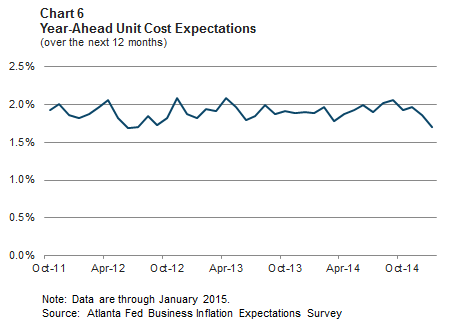
The wage narrative has not changed since our last post. Companies that planned to increase wages continued to cite raises in the range of 2 to 3 percent. However, greater increases were being given for highly competitive or difficult to fill positions, and several contacts indicated increasing entry-level wages. Although a significant number of contacts continued to report that they were not feeling any pressure to accelerate the pace of increases, it was becoming more common to hear business leaders anticipating the need to do so.
Investment and credit
Credit conditions continued to improve. Smaller businesses reported somewhat easier credit availability while the capital expenditure picture in the District changed as a result of the decline in energy prices. Firms that use large quantities of oil and gas were aggressively moving forward with their expansion plans, and exploration spending was being cut.
Business outlook
Our directors and contacts remain optimistic, with 66 percent expecting higher growth over the next three to six months compared to current growth rates, the second strongest showing since we began this measurement over two years ago, bested only by the December 2014 reading of 70 percent (see chart 7).
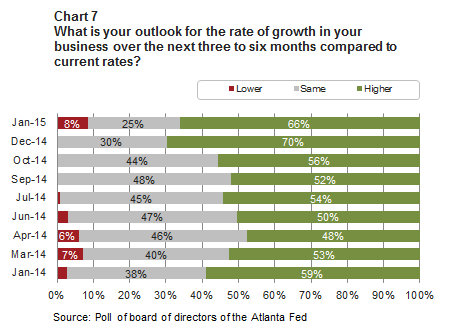
The longer-term view continues to be very positive, with 77 percent expecting their rate of growth to be higher over the next two to three years when compared to current growth (see chart 8).
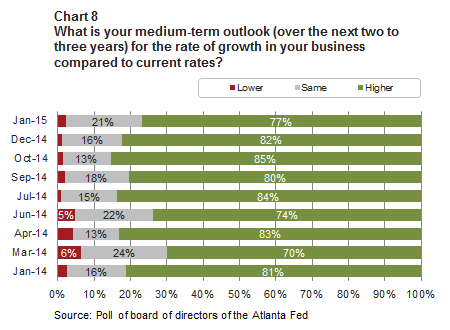
Although some headwinds have been identified and are certainly worth watching, overall, indications from our directors and contacts point to continued economic growth for the District. How does this align with your experience and sentiment?
By Lesley McClure, vice president and regional executive; Teri Gafford, director, Regional Economic Information Network, both in the Atlanta Fed's Birmingham Branch; and Shalini Patel, director, Atlanta Fed's Regional Economic Information Network



